We’d like to remind Forumites to please avoid political debate on the Forum.
This is to keep it a safe and useful space for MoneySaving discussions. Threads that are – or become – political in nature may be removed in line with the Forum’s rules. Thank you for your understanding.
📨 Have you signed up to the Forum's new Email Digest yet? Get a selection of trending threads sent straight to your inbox daily, weekly or monthly!
Problem with composite door lock mechanism.
Comments
-
JohnB47 said:
Are you saying the door cannot be adjusted? What are those little slotted white things I wonder?Er, looks like adjustment screws... :-(I'm guessing they push the hinge away from the door jamb, so effectively 'square up' the whole door within its frame.Are there two hinges or three?Anyhoo, with the door closed, see how it sits within its frame - is there an even gap all around it? In particular, is the vertical gap even all the way down the lock/handle side of the door?(If the hinges do need a little adjustment, it would appear that the process would be to first slacken the hinges screws a bit, turn the white screws IN for pushing the hinge out, and vicky-verka, and then you retighten the securing screws.)First, tho' - could we have a pic of the open door edge with the locking bits? And of the receiving door jamb slots? Ie, the opposite side to the hinges.1 -
This may be too simple but what about the plates the lock goes into?The house I moved into I had a problem with the door not always wanting to lock and examination showed the plate in the door frame was moving though it wasn't obvious just by looking. It was a case of tightening a screw and getting the plate just right. It did come loose a couple of times but now 18mts on it's stayed where it was put.I had a similar problem on the back door but no loose screw. However adjusting the position of the plate sorted that too.
I can rise and shine - just not at the same time!
viral kindness .....kindness is contageous pass it on
The only normal people you know are the ones you don’t know very well
1 -
Good chance, 2'penny.There's often only a mm involved, sometimes a fraction of. If the striker plate has dropped a teeny bit, that can be enough. Or if the door has ditto, or in this case fallen slightly out of square (since it doesn't look as tho' it can 'drop')..John? Never mind the heat - what are the door gaps like?! And where are these photos...0
-
Thanks again everyone.
A tiny bit busy today. I will reply more fully later this morning, with (much smaller) photos. A quick feel around the frame edges and plates finds nothing loose or obviously out of place.1 -
OK, here we go. Attached are some small pictures of various parts of the door. There are three hinges. The only slightly odd thing I've found is some sticky gunge on the locking hooks and where they fit into the door frame sockets. Not much really, just a bit of gunge. Can't really see this giving a problem. I'll clean that off with petrol on a cloth.Jeepers_Creepers said:JohnB47 said:
Are you saying the door cannot be adjusted? What are those little slotted white things I wonder?Er, looks like adjustment screws... :-(I'm guessing they push the hinge away from the door jamb, so effectively 'square up' the whole door within its frame.Are there two hinges or three?Anyhoo, with the door closed, see how it sits within its frame - is there an even gap all around it? In particular, is the vertical gap even all the way down the lock/handle side of the door?(If the hinges do need a little adjustment, it would appear that the process would be to first slacken the hinges screws a bit, turn the white screws IN for pushing the hinge out, and vicky-verka, and then you retighten the securing screws.)First, tho' - could we have a pic of the open door edge with the locking bits? And of the receiving door jamb slots? Ie, the opposite side to the hinges.
The door doesn't really seem out of true. It is ever so slightly bowed inwards at the top and bottom (on the locking mechanism side) but nothing really serious. The gap all round looks normal.
Cheers.
Working fine at the moment.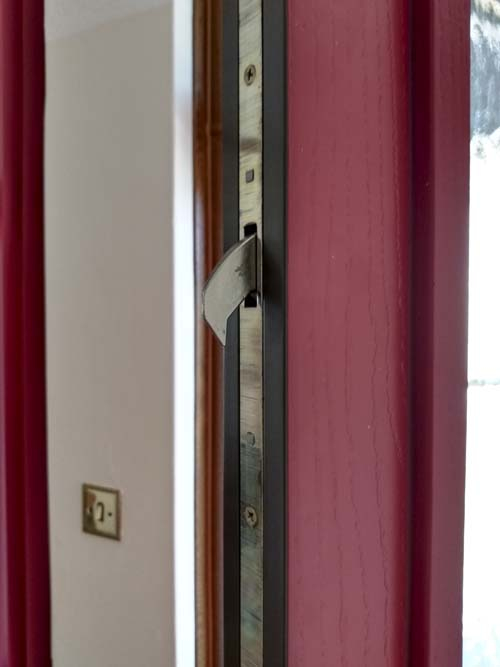
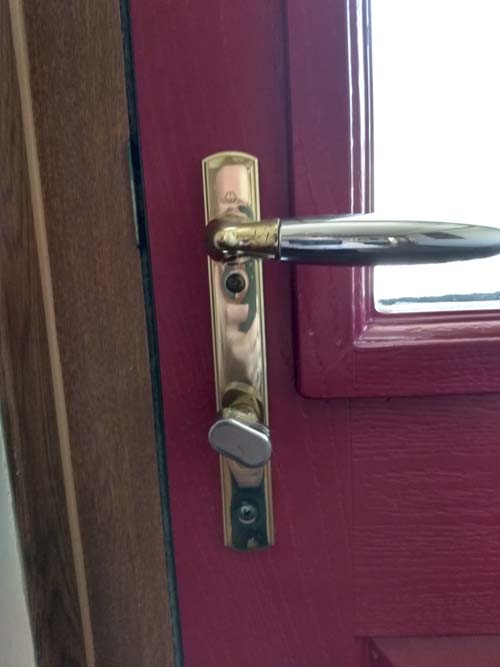
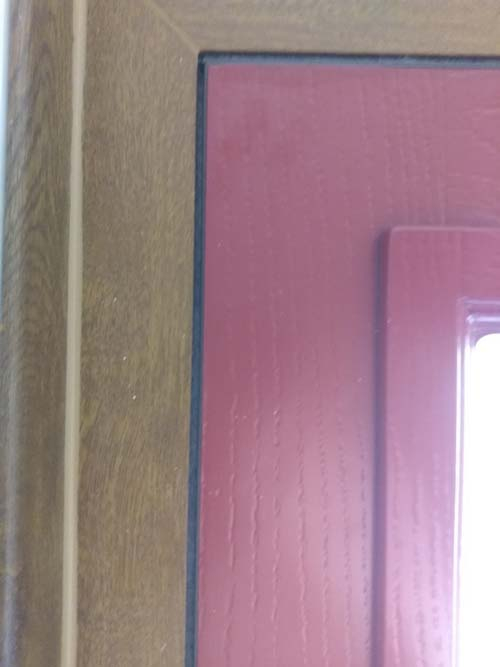
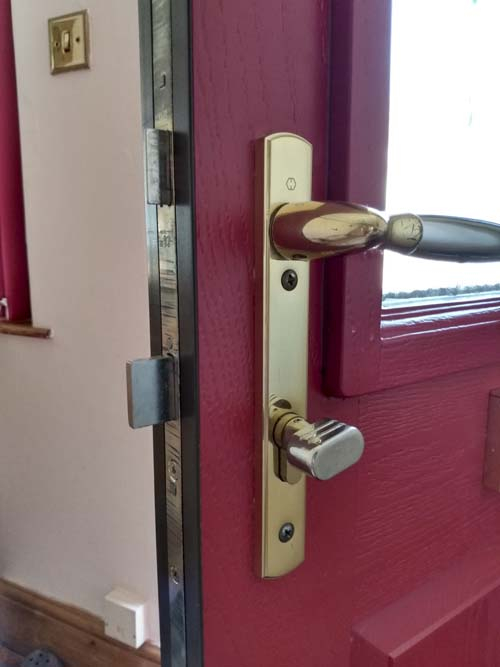
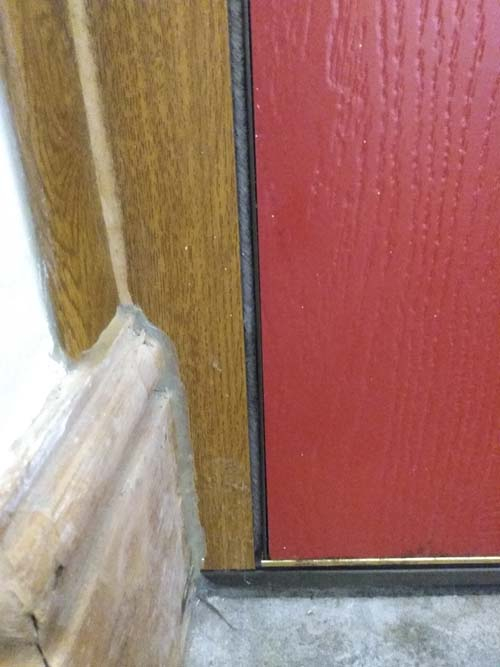
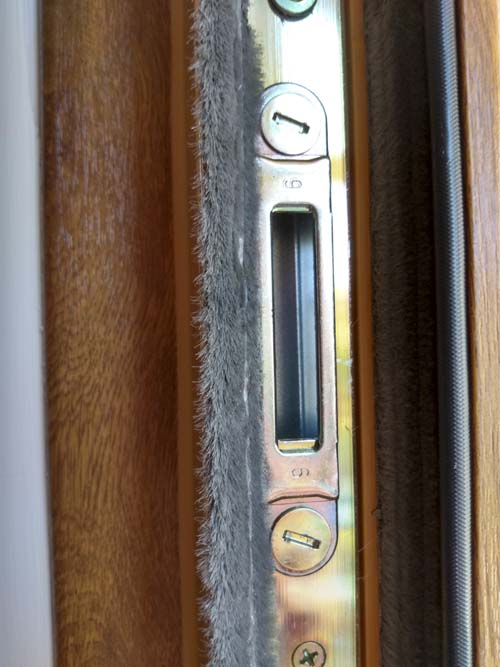
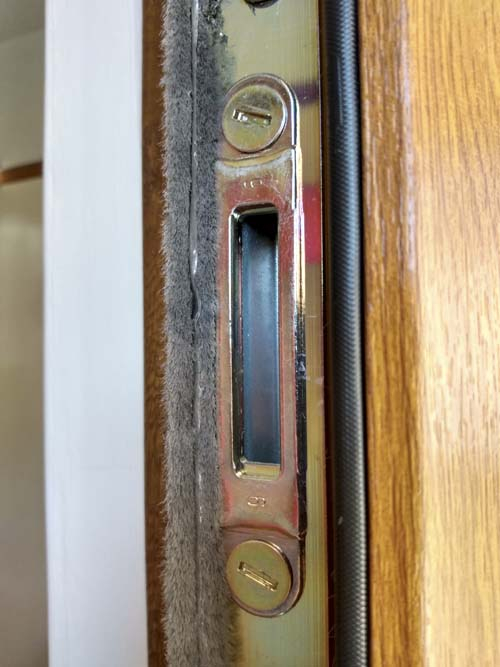
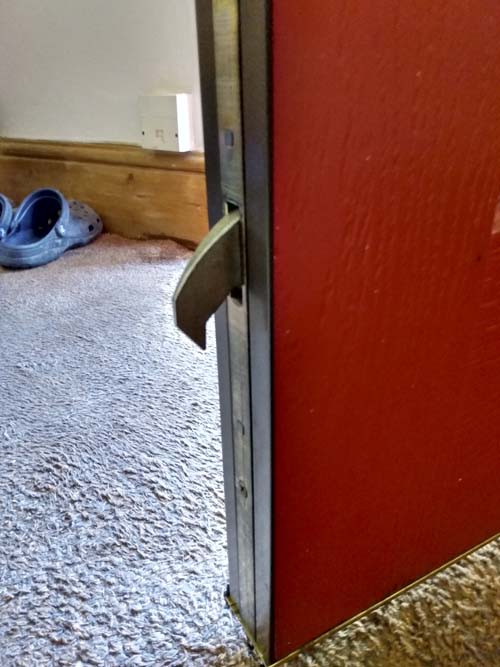
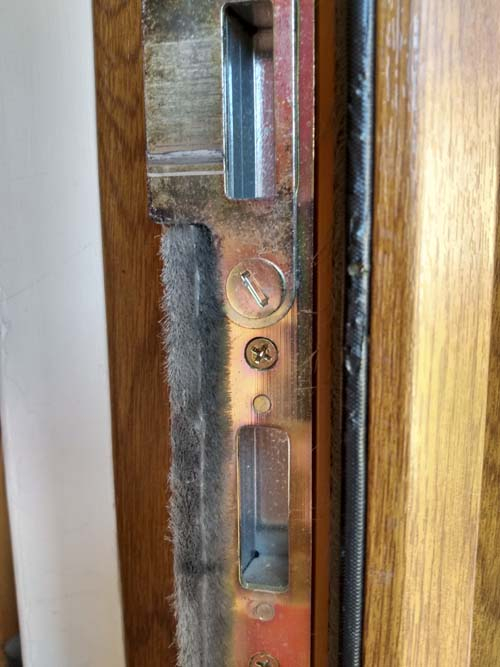
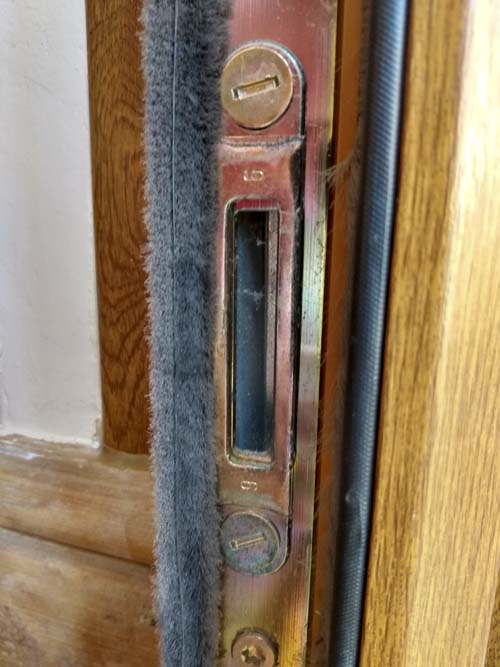 1
1 -
doors can swell or bow in this weather dark doors . you have red and oak frame . If its working well when open the problem, is with the contact claws at keepers . they are adjustable . as it the hinge slightly with the small slotted grub screws . see if the space is equal all around the door . Put he locks to open and stick a bit of lippy on the keepers . Close it then try the door shut . the lippy should mark where its tight or knocking . Adjust the frame keepers . normal a 4 allen key or pozzi . split spindle is exactly that . works inside as it should . Doesn't engage outside so you cant push the handle down and walk in without the use of the key . if you take off your handle you may have more of an idea how this works . Note ,, make sure you do key lock it when going out or to bed . would take me 10 seconds to get in quietly if you never . 5 if your letterbox is central .
1 -
Good info and pics, John.The door looks pretty 'square', so I personally wouldn't touch the hinges, especially as they are of the type they are - just a bit more awkward to tweak (you could get into some bother, and make them worse).The locking 'claws' - how many of them are there? You have shown two, and they both point downwards. I'd be suspecting 'downward' types like this first. The most common issue with them is that they make contact with the bottoms of their receiving slots before the handle has manage to go through its full locking movement.Ie, when you lift the door handle to extend these claws (and the main straight locking bolt), they need to be able to 'extend' the full amount, so that the handle can go 'up' the full amount - before the actual key can then be turned. If anything stops these 'claws' from moving their full range, then the key can't be turned.Looking at you pic here, the green arrow points to the area that may be causing the problem - this is probably the bit the claw hits too early, and which stops it from going any further. Greenface's idea of putting some lippy on the claw - especially its underside edge - and then trying to lock the door is a good one - see if it makes actual contact with that bottom edge (green arrow).The red arrow points to what are either securing screws or adjustment screws for these slot plates. I'm not sure what they are, but I'd have expected securing screws to have been pozidrive or 'star' type heads. Being 'slotted' suggest they might be adjusting screws? Ie, as you turn them, they are offset 'cams', so the plate moves sideways and up and down in a small circle. That's a guess...Do you have a flat-blade screwdriver? Cool. Could you try it in one of these slots and see what turning it does?And please report back when you've applied yer lippy.1
-
Thanks greeenface. The claws do have marks, on the inner surfaces (and had a bit of gunge - now removed) where they rubbed against the inner edge of the keepers. I wondered if this was normal - to keep the door held against the weatherproof brushing/doorseal.
You seem to be saying that the claws should not rub against any surface of the keepers as the door handle is pulled up. Is that so?0 -
Thanks - did you intend to attach modified images? Nothing showing.Jeepers_Creepers said:Good info and pics, John.The door looks pretty 'square', so I personally wouldn't touch the hinges, especially as they are of the type they are - just a bit more awkward to tweak (you could get into some bother, and make them worse).The locking 'claws' - how many of them are there? You have shown two, and they both point downwards. I'd be suspecting 'downward' types like this first. The most common issue with them is that they make contact with the bottoms of their receiving slots before the handle has manage to go through its full locking movement.Ie, when you lift the door handle to extend these claws (and the main straight locking bolt), they need to be able to 'extend' the full amount, so that the handle can go 'up' the full amount - before the actual key can then be turned. If anything stops these 'claws' from moving their full range, then the key can't be turned.Looking at you pic here, the green arrow points to the area that may be causing the problem - this is probably the bit the claw hits too early, and which stops it from going any further. Greenface's idea of putting some lippy on the claw - especially its underside edge - and then trying to lock the door is a good one - see if it makes actual contact with that bottom edge (green arrow).The red arrow points to what are either securing screws or adjustment screws for these slot plates. I'm not sure what they are, but I'd have expected securing screws to have been pozidrive or 'star' type heads. Being 'slotted' suggest they might be adjusting screws? Ie, as you turn them, they are offset 'cams', so the plate moves sideways and up and down in a small circle. That's a guess...Do you have a flat-blade screwdriver? Cool. Could you try it in one of these slots and see what turning it does?And please report back when you've applied yer lippy.1 -
Eek! Here it is:
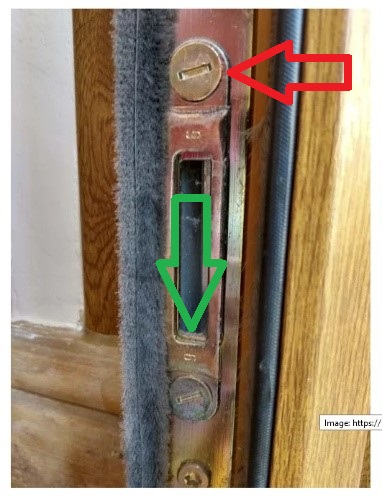 To answer your Q to gf, the 'claws' are bound to have some marks on them as they will be rubbing against the sides of the slots. The important bit is, does the 'inside' of the claw make hard contact with the bottom of the slot. Does the bottom of the slot 'stop' the claw's travel by even a fraction of a mm?(Check them all - only one has to stop the travel.)0
To answer your Q to gf, the 'claws' are bound to have some marks on them as they will be rubbing against the sides of the slots. The important bit is, does the 'inside' of the claw make hard contact with the bottom of the slot. Does the bottom of the slot 'stop' the claw's travel by even a fraction of a mm?(Check them all - only one has to stop the travel.)0
Confirm your email address to Create Threads and Reply

Categories
- All Categories
- 352.8K Banking & Borrowing
- 253.8K Reduce Debt & Boost Income
- 454.7K Spending & Discounts
- 245.9K Work, Benefits & Business
- 601.9K Mortgages, Homes & Bills
- 177.7K Life & Family
- 259.8K Travel & Transport
- 1.5M Hobbies & Leisure
- 16K Discuss & Feedback
- 37.7K Read-Only Boards


